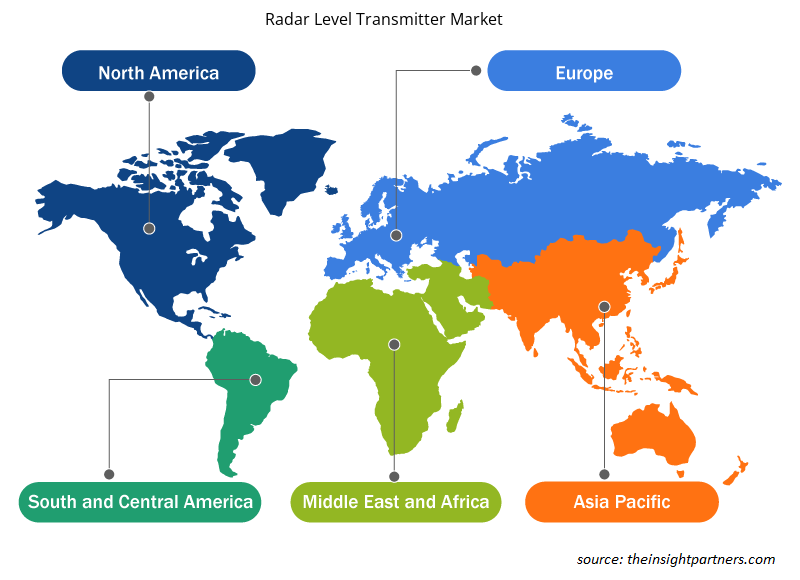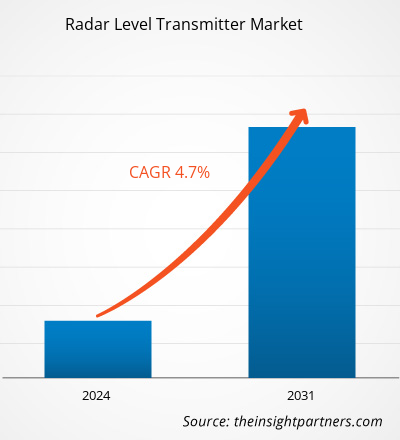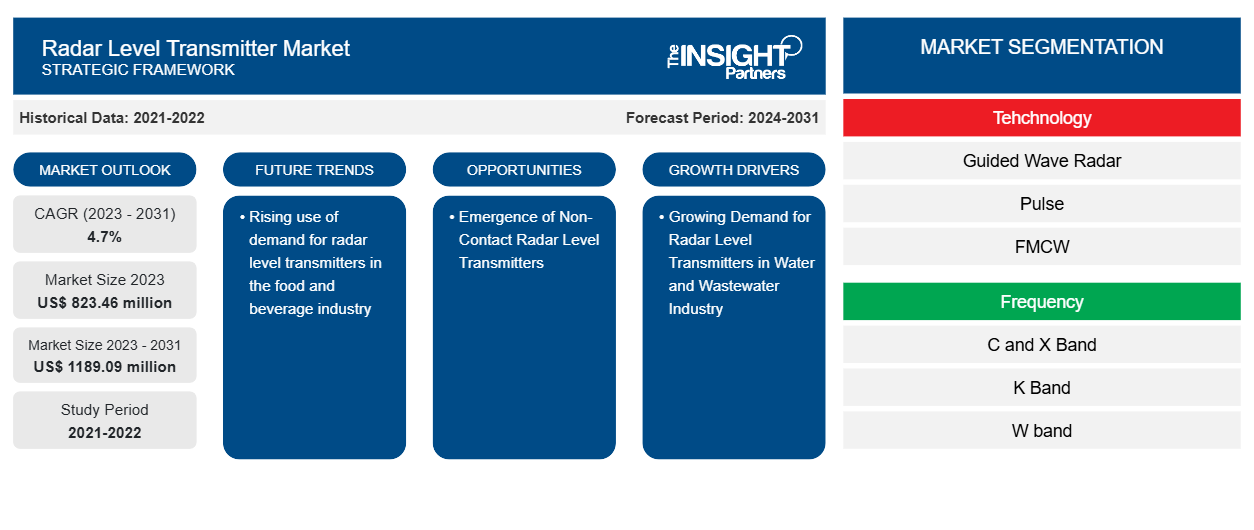Se proyecta que el tamaño del mercado de transmisores de nivel por radar alcance los 1189,09 millones de dólares estadounidenses en 2031, frente a los 823,46 millones de dólares estadounidenses en 2023. Se espera que el mercado registre una CAGR del 4,7 % entre 2023 y 2031. Es probable que la creciente demanda de transmisores de nivel por radar en la industria de alimentos y bebidas siga siendo una tendencia clave del mercado.
Análisis del mercado de transmisores de nivel por radar
El mercado de transmisores de nivel por radar está creciendo debido a los beneficios de alta estabilidad, confiabilidad y precisión que ofrecen estos transmisores. Además, el creciente énfasis en la optimización y la eficacia de los activos está impulsando el crecimiento del mercado a nivel global. Además, existe una creciente demanda de transmisores de nivel por radar inalámbricos, especialmente para aplicaciones en áreas remotas dentro de los sectores de minería, petróleo y gas, y químico y petroquímico, lo que está impulsando aún más el crecimiento del mercado de transmisores de nivel por radar . Además, la expansión de las mejoras industriales y económicas en las economías emergentes está creando nuevas oportunidades para que los actores del mercado brinden soluciones más avanzadas a sus clientes, lo que impulsa aún más el crecimiento del mercado de transmisores de nivel por radar.
Descripción general del mercado de transmisores de nivel por radar
Los transmisores de nivel por radar son dispositivos electrónicos que se utilizan para medir los niveles de fluidos. Estos transmisores de nivel ayudan a detectar los niveles de fluidos mediante tecnología de radar. Numerosas industrias, incluidas las de alimentos y bebidas, fabricación, construcción, petróleo y gas e industria, hacen un uso extensivo de la tecnología de transmisores de nivel por radar. Esta tecnología se basa en el cálculo del tiempo necesario para completar un recorrido entre el transductor y el nivel del material medido. Los transmisores de nivel por radar son más adecuados para entornos difíciles cuando la niebla, el polvo o una superficie espumosa impiden el uso de un transmisor ultrasónico.
Personalice este informe según sus necesidades
Obtendrá personalización en cualquier informe, sin cargo, incluidas partes de este informe o análisis a nivel de país, paquete de datos de Excel, así como también grandes ofertas y descuentos para empresas emergentes y universidades.
-
Obtenga las principales tendencias clave del mercado de este informe.Esta muestra GRATUITA incluirá análisis de datos, desde tendencias del mercado hasta estimaciones y pronósticos.
Impulsores y oportunidades del mercado de transmisores de nivel por radar
Demanda creciente de transmisores de nivel por radar en la industria del agua y las aguas residuales
El sector del suministro de agua se ve presionado a avanzar en las técnicas de tratamiento del agua a medida que aumenta la exigencia de una calidad del agua constante y la gestión de la calidad del agua se vuelve más estricta y severa. La tecnología de transmisores de nivel por radar es una alternativa muy económica para proyectos hídricos y es capaz de medir niveles en condiciones adversas. Durante el proceso de tratamiento de aguas residuales, es esencial seleccionar el transmisor de nivel de aguas residuales adecuado. Los transmisores de nivel por radar se utilizan para controlar los niveles de aguas residuales en cada etapa de la red de aguas residuales y la técnica de tratamiento, proporcionando un control crucial y una entrada de proceso, lo que está impulsando el crecimiento del mercado de transmisores de nivel por radar a nivel mundial.
Aparición de transmisores de nivel por radar sin contacto
El método sin contacto es más adecuado para aplicaciones sucias, viscosas y corrosivas, así como cuando se utilizan agitadores. Los transmisores de radar sin contacto utilizan tecnología de onda continua modulada en frecuencia (FMCW) para evaluar los niveles. Además, estos transmisores se utilizan para mejorar la precisión y la confiabilidad de las mediciones y se pueden utilizar para una gama más amplia de aplicaciones. Además, la precisión no se ve afectada por las variaciones en la densidad del medio, la temperatura, el polvo y la presión, lo que se espera que cree una oportunidad para el crecimiento del mercado de transmisores de nivel por radar.
Informe de mercado de transmisores de nivel por radar Análisis de segmentación
Los segmentos clave que contribuyeron a la derivación del análisis del mercado de transmisores de nivel de radar son la tecnología, la frecuencia, el medio y la vertical de la industria.
- Según la tecnología, el mercado de transmisores de nivel por radar se segmenta en radar de onda guiada, de pulso y FMCW. El segmento de radar de onda guiada tuvo una mayor participación de mercado en 2023.
- Por frecuencia, el mercado está segmentado en banda C&X, banda K y banda W. El segmento de banda C&X tuvo la mayor participación del mercado en 2023.
- Por medio, el mercado se segmenta en sólido y líquido. El segmento sólido tuvo la mayor participación del mercado en 2023.
- Por sector industrial, el mercado está segmentado en petróleo y gas, productos químicos, alimentos y bebidas, entre otros. El segmento de petróleo y gas tuvo la mayor participación del mercado en 2023.
Análisis de la cuota de mercado de transmisores de nivel por radar por geografía
El alcance geográfico del informe de mercado de transmisores de nivel de radar se divide principalmente en cinco regiones: América del Norte, Asia Pacífico, Europa, Medio Oriente y África, y América del Sur/América del Sur y Central.
En Oriente Medio y África, los transmisores de nivel por radar están experimentando un enorme crecimiento debido a su enorme uso en los sectores de petróleo y gas y químicos. Como la región es uno de los mayores productores de petróleo y gas, la demanda de este transmisor está aumentando. Según la Administración de Comercio Internacional, los Emiratos Árabes Unidos son uno de los diez mayores productores de petróleo del mundo. Alrededor del 96% de las reservas de petróleo del país, alrededor de 100 mil millones de barriles, se encuentran en Abu Dhabi. De manera similar, Arabia Saudita tiene aproximadamente el 17% de las reservas probadas de petróleo del mundo , lo que convierte al país en uno de los mayores exportadores de petróleo. Además, el país tiene las segundas reservas probadas de petróleo más grandes del mundo. Además, los gobiernos de los países mencionados están tomando diversas iniciativas para aumentar la producción de petróleo, lo que está impulsando aún más el crecimiento del mercado de transmisores de nivel por radar.
Perspectivas regionales del mercado de transmisores de nivel por radar
Los analistas de Insight Partners explicaron en detalle las tendencias y los factores regionales que influyen en el mercado de transmisores de nivel por radar durante el período de pronóstico. Esta sección también analiza los segmentos y la geografía del mercado de transmisores de nivel por radar en América del Norte, Europa, Asia Pacífico, Oriente Medio y África, y América del Sur y Central.

- Obtenga datos regionales específicos para el mercado de transmisores de nivel por radar
Alcance del informe de mercado de transmisores de nivel por radar
| Atributo del informe | Detalles |
|---|---|
| Tamaño del mercado en 2023 | US$ 823,46 millones |
| Tamaño del mercado en 2031 | US$ 1189,09 millones |
| CAGR global (2023 - 2031) | 4,7% |
| Datos históricos | 2021-2022 |
| Período de pronóstico | 2024-2031 |
| Segmentos cubiertos |
Por tecnología
|
| Regiones y países cubiertos |
América del norte
|
| Líderes del mercado y perfiles de empresas clave |
|
Densidad de actores del mercado de transmisores de nivel por radar: comprensión de su impacto en la dinámica empresarial
El mercado de transmisores de nivel por radar está creciendo rápidamente, impulsado por la creciente demanda de los usuarios finales debido a factores como la evolución de las preferencias de los consumidores, los avances tecnológicos y una mayor conciencia de los beneficios del producto. A medida que aumenta la demanda, las empresas amplían sus ofertas, innovan para satisfacer las necesidades de los consumidores y aprovechan las tendencias emergentes, lo que impulsa aún más el crecimiento del mercado.
La densidad de actores del mercado se refiere a la distribución de las empresas o firmas que operan dentro de un mercado o industria en particular. Indica cuántos competidores (actores del mercado) están presentes en un espacio de mercado determinado en relación con su tamaño o valor total de mercado.
Las principales empresas que operan en el mercado de transmisores de nivel por radar son:
- AMETEK
- TEJIDO
- Compañía Eléctrica Emerson
- Compañía: Honeywell International Inc.
- KROHNE
- Schneider Electric
Descargo de responsabilidad : Las empresas enumeradas anteriormente no están clasificadas en ningún orden particular.

- Obtenga una descripción general de los principales actores clave del mercado de transmisores de nivel de radar
Noticias y desarrollos recientes del mercado de transmisores de nivel por radar
El mercado de transmisores de nivel por radar se evalúa mediante la recopilación de datos cualitativos y cuantitativos posteriores a la investigación primaria y secundaria, que incluye publicaciones corporativas importantes, datos de asociaciones y bases de datos. A continuación, se incluye una lista de los avances en el mercado de los trastornos del habla y el lenguaje y las estrategias:
- KROHNE, Inc. anunció la incorporación de tres transmisores de nivel por radar OPTIWAVE de 24 GHz y tres de 80 GHz a su línea de productos, que complementan los dispositivos de 10 GHz existentes. La gama completa de transmisores de nivel por radar OPTIWAVE FMCW de 2 cables alimentados por bucle para líquidos y sólidos es ideal para industrias que van desde la química y la petroquímica hasta la minería, los minerales y el procesamiento de metales, y cubre aplicaciones para líquidos y sólidos. (Comunicado de prensa, 2022)
- Emerson anunció el desarrollo del transmisor de nivel Rosemount 1408H, el primer dispositivo de radar sin contacto del mundo diseñado específicamente para la industria de alimentos y bebidas. Las características específicas incluyen un diseño compacto e higiénico, tecnología de barrido rápido, enfoque excepcional del haz del radar y comunicaciones IO-Link, lo que ayuda a los fabricantes a optimizar la eficiencia de sus operaciones, reducir las pérdidas de productos y garantizar la seguridad alimentaria. (Fuente: Emerson, comunicado de prensa, 2021)
Informe de mercado sobre transmisores de nivel por radar: cobertura y resultados
El informe “Tamaño y pronóstico del mercado de transmisores de nivel por radar (2021-2031)” proporciona un análisis detallado del mercado que cubre las siguientes áreas:
- Tamaño del mercado y pronóstico a nivel global, regional y nacional para todos los segmentos clave del mercado cubiertos bajo el alcance
- Dinámica del mercado, como impulsores, restricciones y oportunidades clave
- Principales tendencias futuras
- Análisis detallado de las cinco fuerzas de Porter y PEST y FODA
- Análisis del mercado global y regional que cubre las tendencias clave del mercado, los principales actores, las regulaciones y los desarrollos recientes del mercado.
- Análisis del panorama de la industria y de la competencia que abarca la concentración del mercado, el análisis de mapas de calor, los actores destacados y los desarrollos recientes
- Perfiles detallados de empresas
- Análisis histórico (2 años), año base, pronóstico (7 años) con CAGR
- Análisis PEST y FODA
- Tamaño del mercado, valor/volumen: global, regional y nacional
- Industria y panorama competitivo
- Conjunto de datos de Excel
Informes recientes
Informes relacionados
Testimonios
Razón para comprar
- Toma de decisiones informada
- Comprensión de la dinámica del mercado
- Análisis competitivo
- Información sobre clientes
- Pronósticos del mercado
- Mitigación de riesgos
- Planificación estratégica
- Justificación de la inversión
- Identificación de mercados emergentes
- Mejora de las estrategias de marketing
- Impulso de la eficiencia operativa
- Alineación con las tendencias regulatorias























 Obtenga una muestra gratuita para - Mercado de transmisores de nivel por radar
Obtenga una muestra gratuita para - Mercado de transmisores de nivel por radar